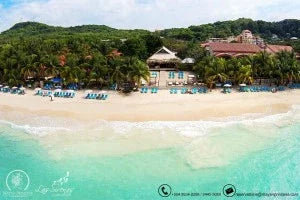
Roatan, Honduras; scuba diving, history and the world's second largest reef
Share
Located between the islands of Utila and Guanaja, Roatán is the largest of the seven Honduras Bay Islands, located in the Caribbean Sea.
Approximately 77 kilometres long, and 8 kilometres at it's widest point, the island has two municipalities; Jose Santos Guardiola and Cayos Cochinos. With a total of 154 km of rich, Carribean coastline, Roatán, Honduras is the divers paradise.
Located near the Mesoamerican Barrier Reef - the largest barrier reef in the Caribbean Sea (and second largest in the world after Australia's), it has become the focus of Roatán's booming tourism trade.
It's history though paints a different picture; Christopher Columbus visited the island on his 1502 - 1504 voyage, just before the Spanish began to raid the island looking for slave labour. But it was exposure to European infectious diseases such as smallpox and measles that devastated the Native American Communities there, with no indigenous people surviving the epidemics.
The majority of the Roatán population originated from the Cayman Islands, arriving in he 1830's, shortly after Britain abolished slavery. In the latter half of the 19th century, the island populations grew steadily and established new settlements all over Roatán and the other islands. Settlers came from all over the world and played a part in shaping the cultural face of the island. The 20th century saw continued population growth with numerous American, Canadian, British, New Zealand, Australian and South African settlers providing the foundation for Roatán's tourist trade.
Roatán's reef systems are very delicate and have experienced massive damage and degradation. On Roatán, tourism development and an increased population are putting a strain on its natural resources. Deforestation, run-off, poorly managed waste treatment, and pollution are the main threats to the terrestrial and marine environments. But Roatán, have made incredible efforts to combat this degradation, and the marine environment looks towards a promising future.

The Roatán Marine Park is a community-based, non-profit organization located on Roatán. Formed in 2005 when a group of concerned dive operators and local businesses united in an effort to protect Roatán’s fragile coral reefs. Initially, their goal was to run a patrol program within the Sandy Bay-West End Marine Reserve, to prevent over exploitation through unsustainable fishing practices. Over time, the organization expanded the scope of their environmental efforts through the addition of other programs to protect Roatán's natural resources, including patrols and infrastructure, education, conservation and public awareness.
The Roatán Marine Park was the main force behind introducing recycling to the Island as well as the popular "Coastal clean up" projects that have become very popular among schools, residents and expatriate communities on the Island. The Marine Park is led by a team of professional divers, marine biologists and oceanographers.
All reef systems throughout the Bay Islands are protected by the local and central government with help from charitable donations and those on the front line. Through local donations to the Marine Park and the many causes along with a concerted effort from the resorts on the island weekly cleanups are undertaken to insure no metals or plastics litter the reef system and beaches as well as all major dive shops doing cleanups on most of their daily dives. There are still obstacles to be defeated but the Islanders and expatriates living on the islands have taken a united stand to conserve and educate. Indeed a lot of countries could learn a thing or two from Roatán.
The Mesoamerican Barrier Reef System is home to more than 65 species of stony coral, 350 species of mollusk and more than 500 species of fish. There are numerous species that live in or around the reef system that are endangered or under some degree of protection, including sea turtles (Green turtle, Loggerhead Sea Turtle, Leatherback turtle, and the Hawksbill turtle), the Queen Conch, Elkhorn coral, and black coral.
On top of the amazing marine life here, Roatán is not short of things to do on land! Whether you are interested in zip lining, hiking, bird watching, or visiting traditional villages, Roatan has enough to keep you busy for your whole trip!
The Mayan Princess Beach Resort is an all-inclusive dive resort located on the beach at popular West Bay. The resort has an on-site dive centre, Mayan Divers, and is rapidly gaining in popularity among savvy divers. Enjoy a 250ft blue lagoon pool & heated 8 person jacuzzi, free wifi, beach volleyball, and canopied shade beds & lounge chairs. Dine at 4 all-inclusive restaurants with á la carte & buffet style natural, low calorie, vegetarian and deli-style menus, as well as unlimited premium drinks including domestic & international liquors, beers & wines and take in daily entertainment like live music and cultural shows.
Roatán is known for it's stunning diving and underwater beauty, but what a lot of tourists don't realize is the rich cultural history of the island, and the adversity's it's faced over hundreds of years. Come with us on Sea The World Adventure Travel's March trip to Roatán, and experience the wonder of both an underwater, and above water paradise.
